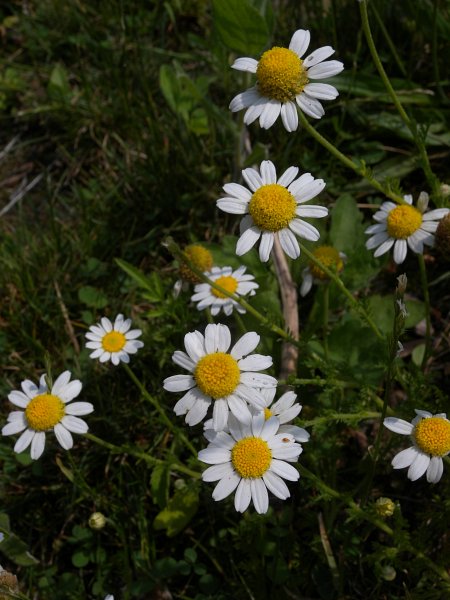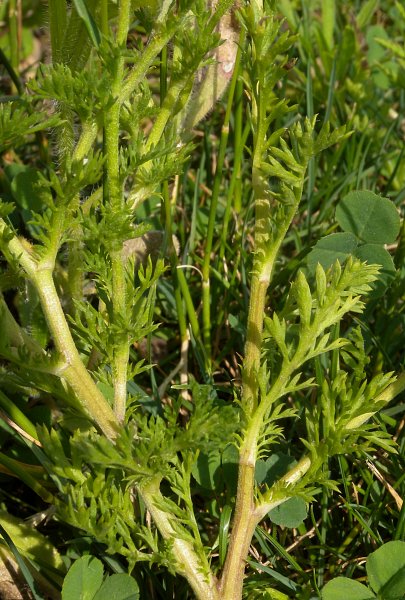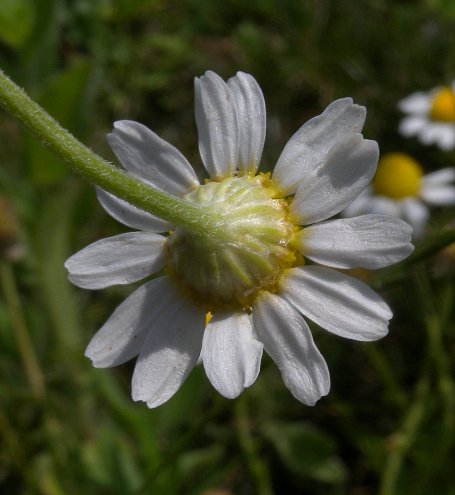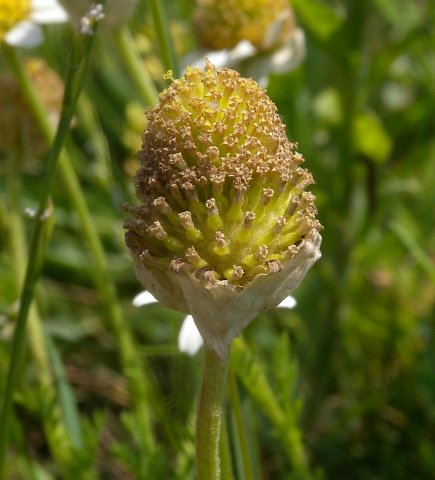
The upper stems terminate in individual flowerheads that span about ¾-1¼" (2-3 cm.) across; these flowerheads have peduncles that are 1½-6" (4-15 cm.) in length. These peduncles are pale green, terete, and woolly-pubescent. Usually, small alternate bracts occur along the peduncles that resemble the leaves. Each daisy-like flowerhead has 10-18 ray florets that surround numerous disk florets; the ray florets are fertile and pistillate, while the disk florets are fertile and perfect. The petaloid rays of the ray florets are white, oblong in shape, and notched at their tips. The tiny corollas of the disk florets are yellow, tubular in shape, and 5-lobed at their apices; these lobes are triangular in shape. Alongside the disk florets, there are chaffy scales about 4 mm. in length. These scales are oblanceolate in shape and their tips are acute; sometimes these tips are awn-like. At the base of each flowerhead, there are 1-2 series of phyllaries (floral bracts) that are broadly oblong in shape. Individual phyllaries have convex central ridges that are light green, wide membranous margins that are white to light brown, and woolly pubescence; the phyllaries become chaffy with age. The foliage of this plant lacks a significant fragrance, although the crushed flowerheads are mildly fragrant (resembling apple-pineapple). The flowerheads are solid, lacking hollow centers. The blooming period usually occurs from late spring to mid-summer, lasting about 1-2 months, although some plants may bloom later in the year.

At maturity, the seedheads are ovoid in shape. The achenes are 1.5-2.5 mm. in length, oblanceoloid in shape, and slightly 4-angled; they are truncate at their apices, where they lack tufts of hair or significant scales. The sides of mature achenes have longitudinal ribs that are readily visible. The achenes are distributed to a limited extent by wind and probably by water at some locations. The root system consists of a shallow much-branched taproot or it is fibrous. Reproduction is by seeds.
Cultivation: The preference is full sun, moist to dry-mesic conditions, and a calcareous soil containing clay-loam, loam, silt, gravel, or sand. Drought tolerance is good. The seeds can remain viable in the ground for 10 years or more (Kay, 1971).
Range & Habitat: Field Chamomile has been found in scattered locations across Illinois (see Distribution Map), but this non-native plant is relatively uncommon within the state. It was introduced into North America from Eurasia, where it is native. In Illinois, habitats consist of fallow fields, roadsides, flood zones along drainage canals and retention ponds, vacant lots and abandoned homestead sites, and waste areas. Highly disturbed areas are preferred.

Faunal Associations: The flowerheads probably attract small bees, various flies (including Syrphid flies), and other insects. Both nectar and pollen are available as floral rewards to such visitors. Insects that feed destructively on Field Chamomile and other Anthemis spp. include Polymerus basalis (Red-Spotted Aster Mirid) and two aphids, Macrosiphoniella tanacetaria and Macrosiphoniella tapuskae. The former aphid is typically found on the flowerheads, peduncles, and upper stems, while the latter aphid is typically found on the lower leaves. The polyphagous caterpillars of a moth, Orthonama obstipata (The Gem), have been reported to feed on mayweeds by Covell (1984/2005). Field Chamomile belongs to the group of plants that are commonly referred to as mayweeds in Europe. The foliage of Field Chamomile is probably browsed sparingly by mammalian herbivores, while Canada Geese seem to avoid it. Because the seeds can pass through the gastrointestinal tracts of both cattle and pigeons and remain viable (Kay, 1971), these animals may spread them to new areas. It is also possible for the seeds to cling to the bottoms of the muddy shoes of people and the muddy hoofs of animals, by which means they can spread to new areas.
Photographic Location: Along a drainage canal and retention pond area in Champaign, Illinois.

Comments: Field Chamomile (Anthemis arvensis) is one of the plants that are commonly referred to as mayweeds. Examples of these species include Anthemis cotula (Dog Fennel), Chamaemelum nobile (Roman Chamomile), Matricaria recutita (German Chamomile), and Tripleurospermum perforatum (Scentless Chamomile). As a group, they are difficult to distinguish from each other. All of these species have daisy-like flowerheads that resemble those of Leucanthemum vulgare (Ox-Eye Daisy), but their foliage is deeply dissected (typically bipinnatifid). Field Chamomile can be distinguished from other mayweeds by its flat leaf-segments (rather than terete leaf-segments), by the presence and shape of the chaffy scales in its flowerheads, by the woolly pubescence of its foliage, and by the appearance of its achenes. The foliage of Field Chamomile lacks the pleasant fragrance of Roman Chamomile, nor does it possess the unpleasant odor of Dog Fennel. Similar to German Chamomile, the crushed flowerheads of Field Chamomile are mildly fragrant, but it has completely solid flowerheads, whereas the flowerheads of German Chamomile have interiors that are partly hollow.